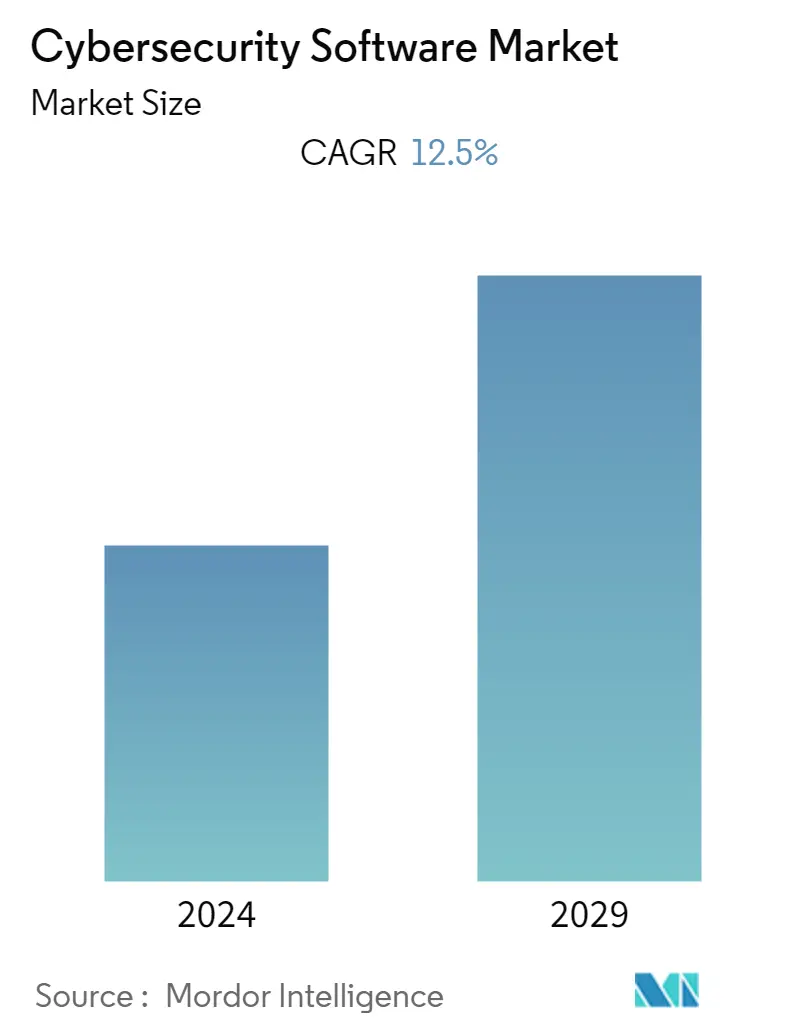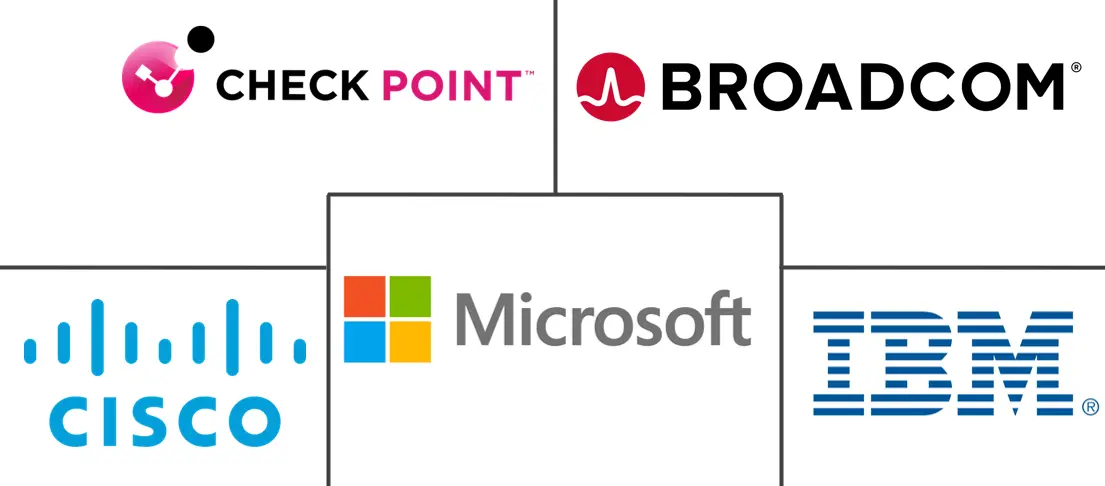Market Size of Cybersecurity Software Industry

| Study Period | 2019 - 2029 |
| Base Year For Estimation | 2023 |
| CAGR | 12.50 % |
| Fastest Growing Market | Asia-Pacific |
| Largest Market | North America |
| Market Concentration | Low |
Major Players
*Disclaimer: Major Players sorted in no particular order |
Cybersecurity Softwares Market Analysis
The cybersecurity software market is expected to register a CAGR of 12.5% during the forecast period. The cybersecurity market is primarily driven by the upswing in cyberattacks happening in various end-user industries. Further, with the growing digitalization, cyberattackers are inventing new ways to conduct cyberattacks; such factors are expected to boost the demand for cybersecurity solutions in the country.
- Cyber security software, often known as computer security software, is used to secure and protect computers, networks, and other computing devices. Because of their extensive overlap and the adage that the best defence is a good attack, this is generally used in defending computer systems or data but can also include programs intended expressly for subverting computer systems.
- Cyber security software assists in managing to access control, the system's protection against viruses, malware, and illegal access, the safety of data, and the defence against other system-level security concerns. Anti-virus software, internet security software, malware/spam ware removal, firewall software, network security software, protection software, and many other forms of cyber security software are available. The growing popularity of digitalization drives the expansion of the cybersecurity software market.
- Cyber security is critical because the government, military, business, financial, and medical entities acquire, process, and store massive amounts of data on computers and other devices. A considerable amount of such data may contain sensitive information, such as intellectual property, financial data, personal information, or different sorts of data whose unlawful access or exposure could have adverse effects.
- The major factors driving the Cyber Security Software Market are an increase in the frequency and sophistication of cyber-attacks, the emergence of disruptive digital technologies such as IoT, stringent data protection regulations for information security, and an increase in the number of supply chain-based attacks that target the software supply chain. Massive cyber attacks are becoming more common around the world.
- Furthermore, Technologies such as the Internet of Things (IoT) and new business models rely heavily on global digitalization for success. As the system becomes more complicated, networked, and handles more information, the attack surface expands, revealing holes in the business's security system. These instances create a massive demand for cybersecurity software services.
- One of the major causes of growing cyberattacks is the lack of skilled cybersecurity personnel in each industry. Experienced cybersecurity professionals, especially in Europe, Asia-Pacific, Latin America, and the Middle East, are less than the need for security professionals to handle the cyber threats for financial institutes, government organizations, and private sector/industrial businesses.
- Innovation can bring about a sustainable, competitive advantage. New markets like Big Data or the IoT are reshaping their security trends. The firm concentration ratio is expected to record higher growth during the forecast period because several software firms look at this market as a lucrative opportunity to consolidate their offerings.
- For instance, In February 2022, Palo Alto Networks inc. announced the launch of Cortex XSIAM, an AI-driven platform to transform how analytics, data, and automation are deployed in the organization's security. It will offer a modern alternative in today's threat landscape.
- The pandemic has further accelerated the need for cybersecurity as enterprises planning to execute months-long business continuity plans (BCP), including information security monitoring and response while operating under quarantine conditions, focused on enhancing cybersecurity. Also, the demand for the cybersecurity software market is rising in the post-pandemic scenario.
- Government agencies are allotting strategic funds to strengthen their digital interface in the post-pandemic era. For instance, In 2021, following recent hospital breaches, French President Emmanuel Macron announced a plan to invest EUR 1 billion (USD1.2 billion) to strengthen cybersecurity in France, with EUR350 million (approx. USD 400 million USD) set aside for hospitals.
Cybersecurity Softwares Industry Segmentation
Cybersecurity software services help an organization monitor, detect, report, and counter cyber threats, which are internet-based attempts to damage or disrupt information systems and hack critical information using spyware and malware, and by phishing to maintain data confidentiality. The study tracks the market based on the spending by the end-users on cybersecurity solutions, as listed in the scope of the study.
The study tracks the key market parameters, underlying growth influencers, and major vendors operating in the industry, which supports the market estimations and growth rates over the forecast period. The study also further analyzes the overall impact of pre and post-Covid-19 scenarios.
The Cybersecurity Software Market is Segmented by offering (Software, services), Deployment (Cloud, On-premises), End-user (BFSI, Healthcare, Manufacturing, Government and Defense, and IT and telecommunication), and Geography (North America, Europe, Asia Pacific, Latin America, and Middle East & Africa).
The market sizes and forecasts regarding value (USD million) for all the above segments are provided.
| By Offering | |
| Software | |
| Services |
| By Deployment | |
| On-premises | |
| Cloud |
| By End User | |
| BFSI | |
| Healthcare | |
| Manufacturing | |
| Government & Defense | |
| IT and Telecommunication | |
| Other End Users |
| By Geography | |
| North America | |
| Europe | |
| Asia Pacific | |
| Latin America | |
| Middle East & Africa |
Cybersecurity Software Market Size Summary
The cybersecurity software market is experiencing significant growth, driven by the increasing frequency and sophistication of cyberattacks across various industries. As digitalization continues to expand, cybercriminals are developing more advanced methods to exploit vulnerabilities, thereby escalating the demand for robust cybersecurity solutions. This market encompasses a wide range of software designed to protect computers, networks, and other digital devices from threats such as viruses, malware, and unauthorized access. The rise in cyber threats is particularly pronounced in sectors like BFSI, healthcare, and government, where sensitive data is stored and processed. The need for enhanced security measures is further amplified by the growing adoption of disruptive technologies like IoT, which expand the attack surface and necessitate more sophisticated defense mechanisms.
North America is poised to be a leading region in the cybersecurity software market, fueled by rapid technological advancements and a strong presence of major cybersecurity firms. The region's focus on innovation and infrastructure development, coupled with increasing cyber threats, particularly in healthcare, drives the demand for advanced cybersecurity solutions. The market is characterized by intense competition and fragmentation, with key players such as Cisco Systems, Microsoft, and IBM leading the charge. Strategic partnerships and acquisitions, like those between CrowdStrike and Mandiant, and Google Cloud's acquisition of Mandiant, highlight the industry's emphasis on innovation and collaboration to address evolving cyber threats. As organizations worldwide prioritize cybersecurity, investments in software solutions are expected to rise, further propelling market growth.
Cybersecurity Software Market Size - Table of Contents
-
1. MARKET INSIGHTS
-
1.1 Market Overview
-
1.2 Industry Attractiveness - Porter's Five Forces Analysis
-
1.2.1 Bargaining Power of Suppliers
-
1.2.2 Bargaining Power of Consumers
-
1.2.3 Threat of New Entrants
-
1.2.4 Threat of Substitutes
-
1.2.5 Intensity of Competitive Rivalry
-
-
1.3 Assessment of COVID-19 Impact on the Cybersecurity Software Market
-
1.4 Market Drivers
-
1.4.1 Increasing Demand for Digitalization and Scalable IT Infrastructure
-
1.4.2 Rapidly Increasing Cybersecurity Incidents and Regulations Requiring Their Reporting
-
-
1.5 Market Challenges
-
1.5.1 Lack of Cybersecurity Professionals
-
-
-
2. MARKET SEGMENTATION
-
2.1 By Offering
-
2.1.1 Software
-
2.1.2 Services
-
-
2.2 By Deployment
-
2.2.1 On-premises
-
2.2.2 Cloud
-
-
2.3 By End User
-
2.3.1 BFSI
-
2.3.2 Healthcare
-
2.3.3 Manufacturing
-
2.3.4 Government & Defense
-
2.3.5 IT and Telecommunication
-
2.3.6 Other End Users
-
-
2.4 By Geography
-
2.4.1 North America
-
2.4.2 Europe
-
2.4.3 Asia Pacific
-
2.4.4 Latin America
-
2.4.5 Middle East & Africa
-
-
Cybersecurity Software Market Size FAQs
What is the current Cybersecurity Software Market size?
The Cybersecurity Software Market is projected to register a CAGR of 12.5% during the forecast period (2024-2029)
Who are the key players in Cybersecurity Software Market?
IBM Corporation, Microsoft Corporation , Cisco Systems, Inc. , Check Point Software Technologies and Broadcom, Inc. are the major companies operating in the Cybersecurity Software Market.

